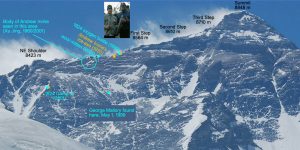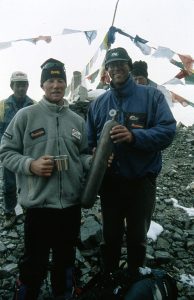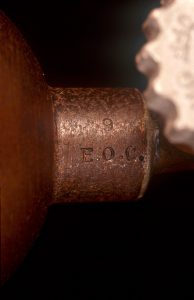Mallory & Irvine’s ascent to 8500 m/28,000 ft.
Mallory & Irvine left C 6 for the summit sometime in the morning of June 8, 1924. Although Mallory had written to photographer John Noel (in his note of the previous day) that they intended to leave “early”, we don’t know if they had indeed managed to do so. However, the following points should be noted:
- Norton & Somervell had originally planned to set off from C 6 at 5:30 a.m. and would probably have done so if they hadn’t been delayed by their need to replace the liquid from a leaking thermos. The two eventually left Camp VI at 6:40 a.m.
- None of the summit parties of the British pre-war expeditions managed to leave C 6 earlier than 5:30 a.m., in most cases due to the extreme cold before sunrise.
- Magnesium flares, a candle lantern and an electric torch later found at the 1924 C 6 strongly suggest that Mallory & Irvine started their climb after sunrise, when it was already light enough to see. They would not have been aided by moonlight, as the moon had already set before midnight. Sunrise had been at 4.45 a.m. that day.
The only conclusion that can be drawn so far is that Mallory & Irvine are likely to have left Camp 6 for the summit sometime between 5 and 7 a.m.
To this day, all traces that have ever been found of Mallory & Irvine’s movements above C 6 (with the
exception of Mallory’s body) were discovered along a 200-metre-long stretch of the Northeast Ridge
between the exit from the Yellow Band (just SW of the twin rock towers) at 8440 m/27,690 ft. and the
base of the First Step at 8500 m/27,890 ft. (see Mallory & Irvine: The Discoveries 1924-2010).
The most common interpretation of the traces is that one of them – oxygen bottle No. 9 – was left behind on the ascent, while the other two – Irvine’s ice-axe and an old woollen mitten presumably from 1924 – were left behind on the descent.
Oxygen bottle No. 9 was first sighted by Eric Simonson in 1991 (probably along with a second bottle) and eventually recovered by Tap Richards on May 17, 1999 (see Tap Richards and Eric Simonson with oxygen bottle no. 9, © Jochen Hemmleb).
The unique valve assembly, shape, and size as well as a stamp “E.O.C.” (“Everest Oxygen Cylinder”) conclusively identified the bottle as stemming from the 1924 British Everest Expedition and therefore from Mallory and Irvine, the only climbing party that used oxygen (see The stamps on the valve stem, © Rick Reanier/Jochen Hemmleb).
In addition, No. 9 appears as one of five oxygen bottles noted on a letter envelope found with Mallory’s body (see image 1).
The location of the bottle has subsequently been established as being c. 170-180 m horizontally away from the top of the First Step (i.e. down the ridge, or to the NE), at an altitude of c. 8470-8475m / 27,790-27,806 ft.
There is, however, some uncertainty about the exact location and circumstances of the bottle’s rediscovery. Dave Hahn appeared to recall seeing an old oxygen bottle sticking out of the snow below the exit from the Yellow Band during the ascent. A sherpa had picked up this bottle and later cached it higher up the ridge. From the testimonies of Hahn and Richards it isn’t entirely clear whether the bottle seen by Hahn on the ascent was the same later recovered by Richards on the descent – or if the bottle found by Richards was another, second, bottle.
From the notes on the envelope found with Mallory, bottle No. 9 contained 110 atmospheres of oxygen, or 11/12 of the full content of 120 atmospheres. This equals a content of 490 litres of oxygen.
The flow rate recommended by medical experts in 1924 for climbs above C 6 was between 2 and 2.5 litres per minute. In this case, bottle No. 9 would have lasted 196-245 minutes, or 3¼ – 4 hours, if used continuously.
Assuming continuous oxygen usage at a constant flow rate, bottle No. 9 might indicate that Mallory and Irvine took between 3¼ – 4 hours to climb from C 6 (8140 m/26,707 ft.) to a point on the Northeast Ridge somewhere between c. 8420 m/27,626 ft. and 8475 m/27,806 ft. Given the many uncertainties in both the departure time from C 6 and the exact location of bottle No. 9, the most optimistic estimation is that Mallory and Irvine reached a point close to the base of the First Step around 8:30 a.m. (i.e. roughly in accordance with Mallory’s schedule, as written in his note to Noel) – but they could have arrived at this point considerably later, perhaps as late as 11 a.m.
If the place where the bottle was recovered in 1999 does indeed mark the spot where it had been discarded in 1924, then bottle No. 9 is to this date the highest trace ever found of Mallory and Irvine. There is no further hard evidence about their ascent beyond this point.


